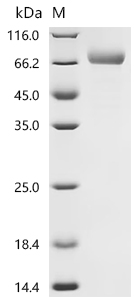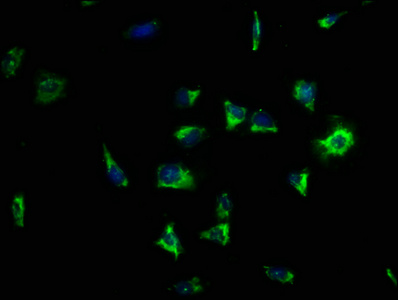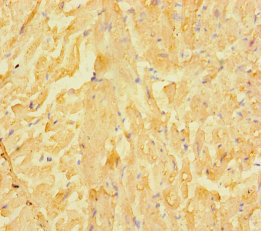LRRC15 (leucine-rich repeat protein 15) is a transmembrane protein that plays an important role in tumor microenvironment regulation, viral infection mechanism, and fibrotic diseases. This article systematically expounds the molecular structure, expression regulation, signaling pathway participation mechanism and pathological function of LRRC15 in related diseases, and summarizes the progress of targeted drug development to provide reference for related mechanisms and clinical research.
1. What is LRRC15
1.1 Molecular structure and characterization of LRRC15
LRRC15 is a type I transmembrane protein, the encoding gene is located on human chromosome 3q29, and the extracellular domain contains 15 leucine repeats (LRRs), forming a horseshoe-shaped structure that mediates protein-protein interactions. The transmembrane domain is in close proximity to the extracellular domain and the intracellular domain is short [1,2]. Under normal physiological conditions, LRRC15 is mainly expressed in placental trophoblast cells, hair follicles, tonsils, gastric mucosa and other tissues, and is significantly up-regulated in tumor-associated fibroblasts (CAFs) and fibrotic tissues under pathological conditions, and its expression is regulated by cytokines such as TGF-β and IL-1β [3,4].
Figure 1. Structure of LRRC15 protein [7]
1.2 Biological function of LRRC15
LRRC15 promotes tumor cell adhesion, migration, and invasion by binding fibronectin and β1 integrin [3]. In mesenchymal stem cells (MSCs), LRRC15 synergistically regulates stem cell stemness with the transcription factor TWIST1, and LRRC15+ MSCs exhibit greater proliferative capacity and therapeutic potential [4].
2. Mechanism of action of LRRC15
2.1 Regulation of tumor microenvironment
LRRC15 is mainly expressed in CAFs, which promotes tumor progression by remodeling the extracellular matrix (ECM) and modulating the immune microenvironment. Single-cell RNA sequencing showed that LRRC15+ CAFs expressed collagen and immunosuppressive factors in pancreatic ductal adenocarcinoma and ovarian cancer, which was associated with poor response to immune checkpoint inhibitors [3, 5]. Mechanistically, LRRC15 activates focal adhesion kinase (FAK)/Src signaling pathway and promotes ovarian cancer cell migration [6]. At the same time, breast cancer cell invasion is regulated through the Wnt/β-catenin pathway [3].
2.2 Viral infection and immune regulation
LRRC15 acts as a coreceptor for the SARS-CoV-2 spike protein and synergistically promotes viral invasion with ACE2, but LRRC15+ fibroblasts can also inhibit the spread of infection by sequestering viral particles [7-9]. Structural studies show that LRRC15 binds to the S1 subunit of spike protein with an affinity of 68.8 nM, which is lower than the 11.6 nM of ACE2 [7]. In addition, LRRC15+ CAFs secrete TGF-β and IL-10, inhibit T cell function, and form an immunosuppressive microenvironment [3,10].
2.3 Fibrosis regulation
In a bleomycin-induced model of pulmonary fibrosis, LRRC15+ MSCs transplantation reduces collagen deposition by inhibition of the TGF-β/Smad signaling pathway [4]. In infrapatellar fat pad fibrosis in osteoarthritis, high expression of LRRC15 promotes fibroblast activation and collagen synthesis [11].
3. LRRC15 related signaling pathways
TGF-β induces LRRC15 transcription through Smad2/3 phosphorylation, which in turn binds to TGF-β receptors, prolongs signaling, and promotes the expression of collagen genes such as COL1A1 [3,4].
3.2 FAK/Src signaling pathway
LRRC15 binds to integrin β1 and activates FAK Tyr397 phosphorylation, recruits Src family kinases, activates PI3K/AKT and MAPK pathways, and drives cell migration [3]. In osteosarcoma cells, inhibition of LRRC15 reduces FAK phosphorylation levels [12].
3.3 TWIST1-LRRC15 axis
In MSCs, TWIST1 directly binds to the LRRC15 promoter to regulate its expression. TWIST1 overexpression increases the proportion of LRRC15+ MSCs, and these cells are highly expressing stem cell markers (e.g., ID1, BMI1) and therapeutic cytokines (e.g., IL-1RA) [4].
4. LRRC15-related diseases
4.1 Malignant tumors
4.1.1 Sarcoma
LRRC15 is highly expressed in soft tissue sarcomas (e.g., undifferentiated pleomorphic sarcoma, osteosarcoma), and ABBV-085, an antibody-drug conjugate (ADC) targeting LRRC15, induces tumor regression in sarcoma models, with an objective response rate of 20 percent in patients with osteosarcoma in phase I clinical trials [3,12,13].
4.1.2 Ovarian cancer
LRRC15 is highly expressed in ovarian cancer CAFs, and knockdown of LRRC15 can reduce abdominal metastasis. Mechanistically, LRRC15 promotes the adhesion of cancer cells to the peritoneal mesotheliium through FAK signaling [6].
4.1.3 Other solid tumors
LRRC15 is negatively correlated with tumor aggressiveness in glioblastoma [5], and high expression in lung adenocarcinoma is associated with improved 5-year survival [1].
4.2 Fibrotic diseases
4.2.1 Pulmonary fibrosis
Transplantation of LRRC15+ MSCs attenuates bleomycin-induced pulmonary fibrosis in the lung tissue of patients with COVID-19 [4,7].
4.2.2 Osteoarthritis
Patients with osteoarthritis have an increased proportion of LRRC15+ fibroblasts in the infrapatellar fat pad, promoting fibrosis [11].
4.3 Viral infectious diseases
LRRC15 is involved in SARS-CoV-2 invasion, but overexpression isolates viral particles; Multiomic studies have shown that decreased LRRC15 levels are associated with severe COVID-19 [7,14].
5. Research progress in drugs targeting LRRC15
At present, the drug research targeting LRRC15 is still in the early stage, and a number of ADC drugs are in the preclinical research stage, and the indications are mainly tumors. In addition, drug type pipelines such as fusion proteins and bispecific T cell engagers are under development. Some of them are listed in the table below:
| Drugs |
Mechanism of action |
Type of medication |
Indications under investigation (disease name) |
Institutions under research |
Highest R&D stage |
| LRRC15-IFNα |
IFNAR agonist | LRRC15 inhibitors |
Fusion proteins |
tumor |
Bonum Therapeutics, Inc. |
Preclinical |
| LNTH-2403 |
LRRC15 inhibitors |
Radiation & Diagnostic Drugs |
Osteosarcoma | Solid tumors |
Lantheus Holdings, Inc. |
Preclinical |
| SOT-106 |
LRRC15 inhibitor | Tubulin inhibitors |
ADC |
Advanced malignant solid tumors | Sarcoma | Solid tumors |
SOTIO Biotech as | Excoso as |
Preclinical |
| H02L0-V1-PBD |
LRRC15 inhibitors |
ADC |
tumor |
Daiichi Sankyo Co., Ltd. |
Preclinical |
| ZL-6201 |
LRRC15 inhibitor | TOP1 inhibitors |
ADC |
Chondrosarcoma | Solid tumors |
Zai Lab (Shanghai) Co., Ltd. | Zai Lab Ltd. | Zai Lab Ltd. (United States) |
Preclinical |
| LRRC15 NovaTE(NovaRock Biotherapeutics) |
CD3 stimulator | LRRC15 inhibitors |
Bispecific T cell binder |
Sarcoma | Solid tumors |
Novarock Biotherapeutics Ltd. |
Preclinical |
| LRRC15-antiTGFβR2 |
LRRC15 inhibitor | TGF-β inhibitors |
Fusion proteins |
tumor |
Bonum Therapeutics, Inc. |
Preclinical |
6. LRRC15 related product recommendation
LRRC15 has multiple regulatory roles in tumors, viral infections and fibrotic diseases, and its specific expression in CAFs and MSCs makes it a potential therapeutic target. CUSABIO provides a variety of highly active recombinant proteins and highly specific antibodies to help you deeply study the cell origin and signaling network of LRRC15, develop precise targeting strategies, and explore its clinical value as a biomarker.
► Please click here to view all LRRC15 related products
References
[1] Woon JYX, et al. Association of LRRC15 protein expression with 5-year survival in lung adenocarcinoma patients. Annals of Oncology. 2024.
[2] Purcell JW, et al. LRRC15 is a novel mesenchymal protein and stromal target for antibody-drug conjugates. Cancer Res. 2018.
[3] Ray U, et al. Exploiting LRRC15 as a Novel Therapeutic Target in Cancer. Cancer Res. 2022.
[4] Toriumi K, et al. LRRC15 expression indicates high level of stemness regulated by TWIST1 in mesenchymal stem cells. iScience. 2023.
[5] Dominguez CX, et al. Single-cell RNA sequencing reveals stromal evolution into LRRC15+ myofibroblasts as a determinant of patient response to cancer immunotherapy. Cancer Discov. 2020.
[6] Ray U, et al. Targeting LRRC15 inhibits metastatic dissemination of ovarian cancer. Cancer Res. 2021.
[7] Loo L, et al. Fibroblast-expressed LRRC15 is a receptor for SARS-CoV-2 spike and controls antiviral and antifibrotic transcriptional programs. PLoS Biol. 2023.
[8] Song J, et al. LRRC15 inhibits SARS-CoV-2 cellular entry in trans. PLoS Biol. 2022.
[9] Shilts J, et al. LRRC15 mediates an accessory interaction with the SARS-CoV-2 spike protein. bioRxiv. 2021.
[10] Krishnamurty AT, et al. LRRC15+ myofibroblasts dictate the stromal setpoint to suppress tumour immunity. Nature. 2022.
[11] Potential Role Of Lrrc15-Expressing Fibroblasts In Infrapatellar Fat Pad Fibrosis In Knee Osteoarthritis.
[12] Slemmons KK, et al. LRRC15 antibody-drug conjugates show promise as osteosarcoma therapeutics in preclinical studies. Pediatr Blood Cancer. 2021.
[13] Ben-Ami E, et al. LRRC15 Targeting in Soft-Tissue Sarcomas: Biological and Clinical Implications. Cancers. 2020.
[14] Gisby JS, et al. Multi-omics identify falling LRRC15 as a COVID-19 severity marker and persistent pro-thrombotic signals in convalescence. Nat Commun. 2022.
CUSABIO team. Targeting LRRC15: From tumor microenvironment regulation to fibrotic/infectious disease therapy. https://www.cusabio.com/c-21238.html














Comments
Leave a Comment